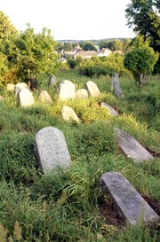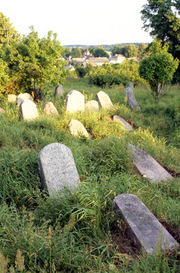
Krynki
Encyclopedia
Krynki ' is a town
in northeastern Poland
, located close to the Belarus
ian border in Podlaskie Voivodeship
. Krynki is famous for its history and its old buildings. It lies approximately 24 kilometres (15 mi) south-east of Sokółka and 45 km (28 mi) east of the regional capital Białystok.
Krynki used to be a multicultural town. Up until 1914, the Jewish population was 9,000 people or about 90% of the town's population. The remainder was made up of Poles, Belarusians
, and others. Today, the majority of Krynki's citizens are Poles, and there is a Belarusian minority.

, the Jews began emigrating to Palestine
and the United States
. During World War II
, in 1941, Germans executed 30 Jews, created a ghetto
, and sent a large part of the Jewish population to the Treblinka extermination camp.
The Jewish population, however, did not remain passive — during an uprising in the ghetto, they killed 12 German policemen, and many Jews escaped. Today, no Jews live in Krynki, but the memory of them still lives on.
Town
A town is a human settlement larger than a village but smaller than a city. The size a settlement must be in order to be called a "town" varies considerably in different parts of the world, so that, for example, many American "small towns" seem to British people to be no more than villages, while...
in northeastern Poland
Poland
Poland , officially the Republic of Poland , is a country in Central Europe bordered by Germany to the west; the Czech Republic and Slovakia to the south; Ukraine, Belarus and Lithuania to the east; and the Baltic Sea and Kaliningrad Oblast, a Russian exclave, to the north...
, located close to the Belarus
Belarus
Belarus , officially the Republic of Belarus, is a landlocked country in Eastern Europe, bordered clockwise by Russia to the northeast, Ukraine to the south, Poland to the west, and Lithuania and Latvia to the northwest. Its capital is Minsk; other major cities include Brest, Grodno , Gomel ,...
ian border in Podlaskie Voivodeship
Podlaskie Voivodeship
Podlaskie Voivodeship , is a voivodeship in northeastern Poland. It borders on Masovian Voivodeship to the west, Warmian-Masurian Voivodeship to the northwest, Lublin Voivodeship to the south, the Belarusssian Voblasts of Grodno and Brest to the east, the Lithuanian Counties of Alytus and...
. Krynki is famous for its history and its old buildings. It lies approximately 24 kilometres (15 mi) south-east of Sokółka and 45 km (28 mi) east of the regional capital Białystok.
History
Krynki gained its town rights in 1569. It lost them in 1950 but it regained them in 2009.Krynki used to be a multicultural town. Up until 1914, the Jewish population was 9,000 people or about 90% of the town's population. The remainder was made up of Poles, Belarusians
Belarusians
Belarusians ; are an East Slavic ethnic group who populate the majority of the Republic of Belarus. Introduced to the world as a new state in the early 1990s, the Republic of Belarus brought with it the notion of a re-emerging Belarusian ethnicity, drawn upon the lines of the Old Belarusian...
, and others. Today, the majority of Krynki's citizens are Poles, and there is a Belarusian minority.

Jewish heritage in Krynki
Jews started living in Krynki in the 17th century when Polish king Wladyslaw IV invited them to the town to develop trade and manufacturing. From that moment, the Jewish population continued growing and their culture flourished.Chasidic Synagogue in Krynki
A notable part of Krynki's history was the Jewish labour movement of 1905. In that year, Jakow Pat led Jewish workers and created the independent Republic of Krynki. After World War IWorld War I
World War I , which was predominantly called the World War or the Great War from its occurrence until 1939, and the First World War or World War I thereafter, was a major war centred in Europe that began on 28 July 1914 and lasted until 11 November 1918...
, the Jews began emigrating to Palestine
Palestine
Palestine is a conventional name, among others, used to describe the geographic region between the Mediterranean Sea and the Jordan River, and various adjoining lands....
and the United States
United States
The United States of America is a federal constitutional republic comprising fifty states and a federal district...
. During World War II
World War II
World War II, or the Second World War , was a global conflict lasting from 1939 to 1945, involving most of the world's nations—including all of the great powers—eventually forming two opposing military alliances: the Allies and the Axis...
, in 1941, Germans executed 30 Jews, created a ghetto
Ghetto
A ghetto is a section of a city predominantly occupied by a group who live there, especially because of social, economic, or legal issues.The term was originally used in Venice to describe the area where Jews were compelled to live. The term now refers to an overcrowded urban area often associated...
, and sent a large part of the Jewish population to the Treblinka extermination camp.
The Jewish population, however, did not remain passive — during an uprising in the ghetto, they killed 12 German policemen, and many Jews escaped. Today, no Jews live in Krynki, but the memory of them still lives on.
Points of interest
- One of the largest, oldest Jewish cemeteries in eastern Poland.
- Two OrthodoxEastern Orthodox ChurchThe Orthodox Church, officially called the Orthodox Catholic Church and commonly referred to as the Eastern Orthodox Church, is the second largest Christian denomination in the world, with an estimated 300 million adherents mainly in the countries of Belarus, Bulgaria, Cyprus, Georgia, Greece,...
churches and cemeteries. - St. Anne's Catholic church, designed by Stefan Szyller who is famous for designing the Poniatowski BridgePoniatowski BridgePoniatowski Bridge is a bridge in Warsaw. Originally built between 1904 and 1914, it was damaged in each of the World Wars and rebuilt afterwards. It spans the Vistula, connecting Powiśle with the Praga quarter on the other side. Its viaduct is an extension of Aleje Jerozolimskie.The 506 m...
in WarsawWarsawWarsaw is the capital and largest city of Poland. It is located on the Vistula River, roughly from the Baltic Sea and from the Carpathian Mountains. Its population in 2010 was estimated at 1,716,855 residents with a greater metropolitan area of 2,631,902 residents, making Warsaw the 10th most...
. - Krynki originally was home to three synagogueSynagogueA synagogue is a Jewish house of prayer. This use of the Greek term synagogue originates in the Septuagint where it sometimes translates the Hebrew word for assembly, kahal...
s. Two are still standing, however one was turned into a cinemaMovie theaterA movie theater, cinema, movie house, picture theater, film theater is a venue, usually a building, for viewing motion pictures ....
, and the other is in ruins. The third, the largest, was burnt down in 1971 by the communist authorities.

